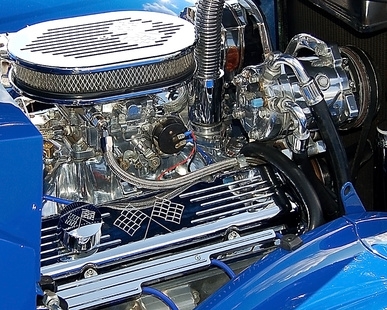
GM used three basic cam-in-block V6 engine designs during the 1980s and 1990s: the Buick 90-degree V6 (which includes the turbo 3.8-liter and later 3800 series), the GM 60-degree V6 (which includes the 2.8-liter and second-generation 3.1-liter) and the 90-degree V6, which was essentially a Chevrolet small-block V8 with two cylinders lopped off. Some engines will bolt to the others' transmission, some will interchange using adapter plates and others won't interchange at all.
GM upgraded or replaced all of its three-speed automatic transmissions during the 1970s, leading to a line of four-speed automatic overdrives. The earlier lighter-duty TH350 and heavy-duty TH400 three speeds had evolved to become the light-duty TH200R4 (a.k.a., 200-4R, 200-R4 and 200R4) and heavy-duty TH700R4 (a.k.a., 7004R, 700-4R and 700-R4) four-speed overdrives. The TH200R4 used a mullti-case bellhousing with bolt patterns to match almost all contemporary GM V8 and V6 engines. The stronger TH700R4 used one of two different bellhousings; the "small-pattern" housing fit the GM 60-degree V6/Buick V6 and the "large-pattern" housing fit GM 90-degree V6 and V8 engines (including the Chevrolet small-block and big-block).
Only GM 60-degree V6 and Buick V6 engines will bolt to a transmission using the small-pattern housing. The reason for this becomes immediately obvious when you look at the engines. 60-degree and 90-degree V6 and V8 engines are so named because of the angle formed by the "V" shape of the block; 60-degree engines have a much narrower "V" than 90-degree engines, making the block itself narrower at its extremes. The small-pattern housing isn't really much physically smaller than the large-pattern housing; it's just narrower and a bit taller.
Bolt pattern itself isn't the issue with small/large-pattern interchanges; an adapter plate will allow you to physically bolt a large-pattern engine to a small-pattern case, or vice versa. The problem lay in the fact that large-pattern engines tend to have larger flex plates and torque converters that won't fit inside the small-pattern's narrower bellhousing. It is for this reason that you often find adapter plates to affix a small-pattern engine to a large-pattern transmission, but not the other way around. If you're fortunate enough to have a 200R4, it will readily adapt to either engine. The same holds true for front-drive transaxles.
Identifying which transmission you have is a matter of crawling under the car and looking at the transmission oil pan. All TH700R4 transmissions use an almost perfectly square oil pan and TH200R4 transmissions use a long, triangular oil pan. There is no way to tell which transmission bellhousing pattern you have without referencing the engine or looking at the housing itself if the engine isn't present.
If you have a small-pattern, 60-degree engine transmission and want to install a 90-degree V6 (like the 4.3-liter), the only viable option is to get rid of your old transmission and install a different one. The good news is that the 90-degree V6 uses the most common bolt pattern GM ever, so it will bolt up to the 4L60 (which is what GM called 700R4s after 1989), the electronically-controlled 4L60, the stronger 4L65E, the dual-pattern TH200R4 and several older three-speeds, including the TH350 and TH400.